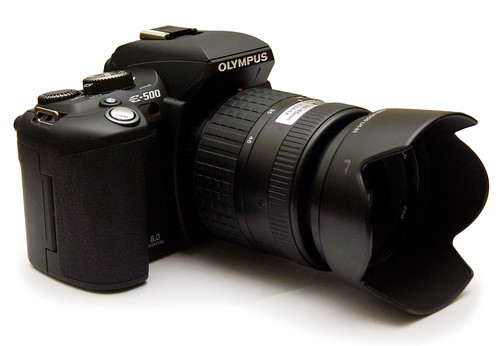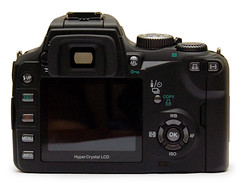Difference between revisions of "Olympus E-500 (EVOLT E-500)"
Timmy Toucan (talk | contribs) m (Fixing links...) |
Hanskerensky (talk | contribs) m (→Reviews: Redirected Link URL to archived version) |
||
| (10 intermediate revisions by 7 users not shown) | |||
| Line 1: | Line 1: | ||
| − | + | {{Flickr_image | |
| − | + | |image_source= http://www.flickr.com/photos/timmythesuk/451240152/in/pool-camerawiki | |
| − | + | |image= http://farm1.static.flickr.com/231/451240152_62398a83e6.jpg | |
| − | [http://www.dpreview.com/news/0509/05092604olympuse500.asp#press Announced] in September 2005, the E-500 (known as the Evolt 500 in some markets) is an 8 megapixel digital SLR conforming to the | + | |image_align= right |
| + | |image_text= | ||
| + | |image_by= Tim Williams | ||
| + | |image_rights= nc | ||
| + | }} | ||
| + | [http://www.dpreview.com/news/0509/05092604olympuse500.asp#press Announced] in September 2005, the '''E-500''' (known as the '''Evolt 500''' in some markets) is an 8 megapixel digital SLR conforming to the [[Four-Thirds]] standard. | ||
On it's release, it was the third interchangeable lens DSLR [[Olympus]] had released for the Four-Thirds system, and was the first to offer premium features, picture quality and performance at such a low price and in such a traditional SLR-style shape (unlike its sister cameras the [[Olympus E-300 (EVOLT E-300)|E-300]] and [[Olympus E-330 (EVOLT E-330)|E-330]] which used the freedom allowed by the smaller sensor to inhabit radically different designs). | On it's release, it was the third interchangeable lens DSLR [[Olympus]] had released for the Four-Thirds system, and was the first to offer premium features, picture quality and performance at such a low price and in such a traditional SLR-style shape (unlike its sister cameras the [[Olympus E-300 (EVOLT E-300)|E-300]] and [[Olympus E-330 (EVOLT E-330)|E-330]] which used the freedom allowed by the smaller sensor to inhabit radically different designs). | ||
| − | The E-500 was the lightest and smallest DSLR at the time of its release, meaning it represented for Olympus all the expected, highly publicised advantages the 4/3rds format offered: compact, lightweight, smaller lenses - and above average picture quality. It also features one-button access to most of its features from the rear panel, including a 'One-Touch WB' function that allows a photographer to target a white object and thereby | + | The E-500 was the lightest and smallest DSLR at the time of its release, meaning it represented for Olympus all the expected, highly publicised advantages the 4/3rds format offered: compact, lightweight, smaller lenses - and above average picture quality. It also features one-button access to most of its features from the rear panel, including a 'One-Touch WB' function that allows a photographer to target a white object and thereby immediately set the correct white balance for the shooting environment. |
| − | The E-500 inherits many operations and features from Olympus' earlier success with the [[Olympus OM| | + | The E-500 inherits many operations and features from Olympus' earlier success with the [[Olympus OM system|OM system]] - notably the highlight and shadow-based spot functions found on the [[Olympus_OM-1/2/3/4#The_OM-3_and_OM-4|OM-4]], and Olympus have released an adaptor for the Four-Thirds system that allows the use of OM lenses on all 4/3rds bodies. The camera features many functions other manufacturers reserve for their higher end DSLR bodies (such as spot metering at only 2%, or exposure compensation up to +/-5 EV), and for two years the E-500 has been the only entry-level digital body available for the 4/3rds system. The E-500's successor, the [[Olympus E-510|E-510]], was announced in March 2007. |
| Line 16: | Line 21: | ||
*Dual lens kit - with the Olympus 14-45mm as above, and a 40-150mm f/3.5-4.5 lens (with an equivalent F.O.V. to 80-300mm on a 35mm body) | *Dual lens kit - with the Olympus 14-45mm as above, and a 40-150mm f/3.5-4.5 lens (with an equivalent F.O.V. to 80-300mm on a 35mm body) | ||
<div class="floatright plainlinks" style="text-align: center;"> | <div class="floatright plainlinks" style="text-align: center;"> | ||
| − | [http://www.flickr.com/photos/timmythesuk/451239098/in/pool- | + | [http://www.flickr.com/photos/timmythesuk/451239098/in/pool-camerawiki/ http://farm1.static.flickr.com/203/451239098_3ae9536ba8_m.jpg]</div> |
<div class="floatright plainlinks" style="text-align: center;"> | <div class="floatright plainlinks" style="text-align: center;"> | ||
| − | [http://www.flickr.com/photos/timmythesuk/451238486/in/pool- | + | [http://www.flickr.com/photos/timmythesuk/451238486/in/pool-camerawiki/ http://farm1.static.flickr.com/251/451238486_ff25126637_m.jpg]<br/><small>images by {{image author|Tim Williams}}</small> {{non-commercial}}</div> |
| Line 36: | Line 41: | ||
== Reviews == | == Reviews == | ||
| − | * [http://www.dpreview.com/reviews/ | + | * [http://www.dpreview.com/reviews/olympuse500/ DP Review] |
| − | * [http://www.dcresource.com/reviews/olympus/e500-review/ Digital Camera Resource Page] | + | * [https://web.archive.org/web/20140408043806/http://www.dcresource.com/reviews/olympus/e500-review/ Digital Camera Resource Page] (archived) |
== Links == | == Links == | ||
| − | * [http://www.olympus.co.uk/ | + | * [http://www.olympus.co.uk/site/en/c/cameras_support/downloads/e_500_downloads.html Olympus' website (UK) E-500 Download area] |
| − | + | ||
[[Category: Japanese digital SLR]] | [[Category: Japanese digital SLR]] | ||
| − | [[Category: Olympus]] | + | [[Category: Olympus|E-500 (EVOLT E-500)]] |
[[Category: 4/3 mount]] | [[Category: 4/3 mount]] | ||
[[Category: O]] | [[Category: O]] | ||
| − | [[Category: E|E-500]] | + | [[Category:E|E-500 Olympus]] |
| + | [[Category:RAW-ORF]] | ||
Latest revision as of 07:23, 13 November 2021

|
| image by Tim Williams (Image rights) |
Announced in September 2005, the E-500 (known as the Evolt 500 in some markets) is an 8 megapixel digital SLR conforming to the Four-Thirds standard.
On it's release, it was the third interchangeable lens DSLR Olympus had released for the Four-Thirds system, and was the first to offer premium features, picture quality and performance at such a low price and in such a traditional SLR-style shape (unlike its sister cameras the E-300 and E-330 which used the freedom allowed by the smaller sensor to inhabit radically different designs).
The E-500 was the lightest and smallest DSLR at the time of its release, meaning it represented for Olympus all the expected, highly publicised advantages the 4/3rds format offered: compact, lightweight, smaller lenses - and above average picture quality. It also features one-button access to most of its features from the rear panel, including a 'One-Touch WB' function that allows a photographer to target a white object and thereby immediately set the correct white balance for the shooting environment.
The E-500 inherits many operations and features from Olympus' earlier success with the OM system - notably the highlight and shadow-based spot functions found on the OM-4, and Olympus have released an adaptor for the Four-Thirds system that allows the use of OM lenses on all 4/3rds bodies. The camera features many functions other manufacturers reserve for their higher end DSLR bodies (such as spot metering at only 2%, or exposure compensation up to +/-5 EV), and for two years the E-500 has been the only entry-level digital body available for the 4/3rds system. The E-500's successor, the E-510, was announced in March 2007.
The E-500 was released in a choice of kits:
- Body only (which includes a rechargeable battery pack with charger)
- Standard Kit - with an Olympus made 14-45mm f/3.5-5.6 lens (with an equivalent F.O.V. to 29-90mm on a 35mm body).
- Dual lens kit - with the Olympus 14-45mm as above, and a 40-150mm f/3.5-4.5 lens (with an equivalent F.O.V. to 80-300mm on a 35mm body)
Some brief Specifications:
- 8 Megapixel CCD sensor - image dimensions up to 3264 x 2448 pixels
- 2.5” rear LCD panel (215,250 pixels; also used in place of the traditional SLR LCD settings display)
- Olympus' patented 'Supersonic Wave Filter' anti-dust system
- Metering: 49 area ESP, Centre-weighted average, Spot (2%), Highlight and shadow-based Spot
- Single AF, continuous AF and manual focusing with all Four-Thirds lenses
- Sequential shooting at 2.5fps (4 images in RAW; until the card is full in medium quality jpeg)
- ISO range 100 - 1600.
- 21 scene programme modes
- Dual slots for CompactFlash (Type I/II or MD) and xD-Picture Cards
- Built-in pop-up flash (GN 13; full TTL operation)
- Weight: 435g
- Size: 129.5 x 94.5 x 66mm
Reviews
- DP Review
- Digital Camera Resource Page (archived)

